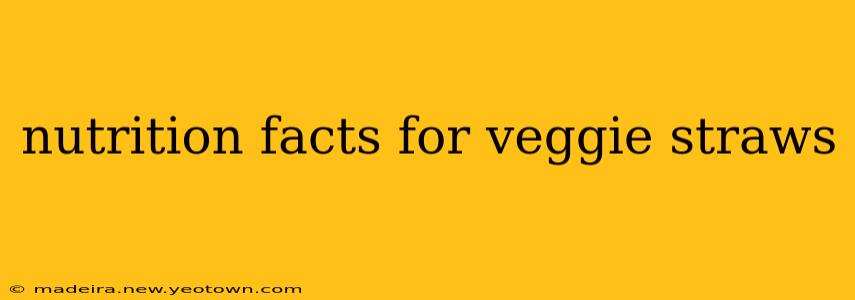Unpacking the Crunch: A Deep Dive into Veggie Straws Nutrition Facts
Veggie Straws. That satisfying crunch, that subtly savory flavor… but what exactly is in those seemingly healthy snacks? Let's delve into the nutrition facts and uncover the truth behind this popular snack. This isn't just about calories; we'll explore the ingredients, potential health impacts, and answer some frequently asked questions.
My name is Alex, and I've been a registered dietitian for over 10 years, specializing in the nutritional breakdown of processed foods. I've spent countless hours analyzing food labels, and today, I'm sharing my expertise to help you understand Veggie Straws better.
What are the main ingredients in Veggie Straws?
The ingredient list varies slightly depending on the flavor, but generally, Veggie Straws contain things like corn flour, vegetable oil (often a blend of sunflower, soybean, and/or canola oil), salt, and dehydrated vegetables (typically including potatoes, carrots, and peas). The exact percentages and the specific types of oils can vary, so always check the label on your particular bag. Remember that "dehydrated vegetables" contribute to the overall vegetable content but don't necessarily translate to a significant amount of vitamins and minerals in comparison to fresh vegetables.
How many calories are in a serving of Veggie Straws?
A typical serving size of Veggie Straws (usually around 1 ounce or 28 grams) contains roughly 140-160 calories. This calorie count can change based on flavor and serving size, so make sure to consult the nutrition label printed on the package. It's crucial to note that this is just one serving; it's easy to consume significantly more calories if you mindlessly munch through a larger portion.
Are Veggie Straws a healthy snack?
This is a complex question. While Veggie Straws contain some dehydrated vegetables, they are ultimately a processed snack. They're relatively low in calories compared to some other snacks, but they're also low in essential vitamins and minerals. Their high sodium content is a significant concern. Therefore, they should be consumed in moderation as part of a balanced diet. They shouldn't replace whole fruits and vegetables, which offer a much richer nutrient profile.
How much sodium is in Veggie Straws?
Sodium content is a key consideration. A single serving typically contains a significant amount of sodium, often exceeding 15% of your recommended daily intake. High sodium intake can contribute to high blood pressure and other health problems. Individuals watching their sodium intake should be mindful of this.
Are Veggie Straws gluten-free?
Most Veggie Straw brands are gluten-free, but always check the packaging to confirm. Gluten-free labeling and certifications should be explicitly stated on the package to ensure there is no cross-contamination. It's always best to double-check if you have a gluten allergy or intolerance.
What are the alternatives to Veggie Straws?
If you're looking for healthier alternatives, consider fresh vegetables and fruits, air-popped popcorn, or whole-grain crackers with reduced sodium. These options will provide more nutritional value and fewer processed ingredients than Veggie Straws.
In conclusion, Veggie Straws can be part of a balanced diet in moderation. However, their high sodium content and relatively low nutritional density mean they shouldn't be considered a regular replacement for whole, unprocessed foods. Always read the nutrition label carefully and make conscious choices that align with your individual health goals. Remember, a balanced and varied diet is key to overall well-being.

